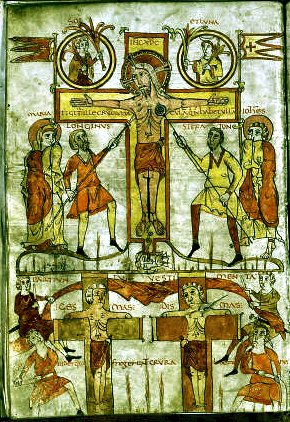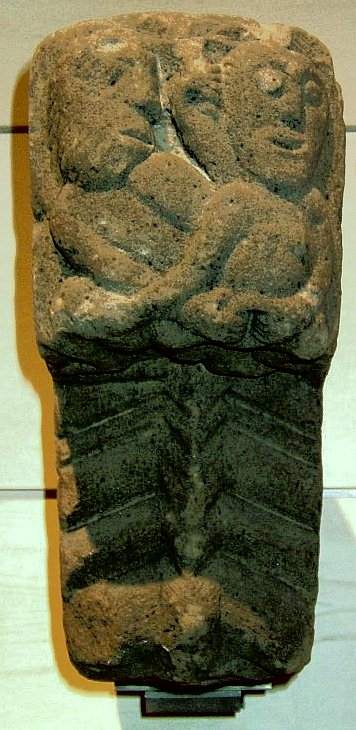Kirknewton (West Lothian, Scotland)
Small voussoir from the church which was demolished in 1780.
It is rare for voussoirs to display images of lust.
|
Now in the Museum of Scotland in Edinburgh, this remarkable
carving has been interpreted as a birth-scene, but it recalls a French
capital at Passirac
(Charente), which is a striking depiction of sexual immorality. A male
figure (left) is helping his partner to pull her thickly-labial vulva,
while she gropes him.
This figure was first reported by Robin Maguire of the sheela-na-gig web-ring news-group. |
Here in the 12th century in a Christian context
we have all the elements
|
Click for more photos on a fraternal site.
In the same museum is a very curious figure from Over Kirkhope in Selkirkshire
on the Scottish Borders.
It certainly looks pre-Romanesque, with a head very like some preserved in
Ireland.
But the interpretation I immediately made - of a strange hermaphrodite possibly
parallelling the celebrated
Boa
Island figures of County Fermanagh - was immediately corrected by my
colleague Julianna Lees
who drew my attention to the similarity of this figure...

photo by Ian Thompson
to this one:

- a Merovingian terra-cotta tile from Auvergne depicting Christ with penis,
a sword to conquer Evil (the snake) and holding the moon on one side
and a torch (representing the sun) on the other. (Museum of National
Antiquities, Saint-Germain-en-:Laye)
So the two 'breasts' on the Over Kirkhope figure are the two celestial
bodies (which feature frequently in Early Mediæval art)
while the penis represents Christ's spiritual and/or protective power, as
explained in French:
|
...une très curieuse plaque de terre cuite à décor moulé - objet n° 80287 - a été découverte avant 1830 avec une vingtaine d'autres tuiles de même grandeur formant le revêtement d'un tombeau sur la commune du Broc (Puy-de-Dôme), à 5 km au sud d'Issoire.Elle a été datée par thermoluminescence du début du haut Moyen Age. Cette interprétation extrêmement populaire du Christ, présentant la croix monogrammatique encadrée de l'alpha et de l'oméga sur le front, empruntant aux représentations impériales le globe et la lance à crochets et foulant le serpent (symbole du mal) selon les paroles du Psaume : "Tu fouleras l'aspic et le basilic, tu écraseras le lion et le dragon" ( d'où les trois têtes de lion dans le champ), dérive de figurations paléochrétiennes. Plus étonnante est
l'adjonction d'un phallus. Signalons pourtant la même survivance
de ce vieux symbole païen (le phallus est considéré
comme doté de vertu protectrice) associé à d'autres
représentations chrétiennes à l'époque mérovingienne. |
And to this one, showing Christ's scrotum:

from the eleventh-century Val de Loire Bible, which also features
the Sun and Moon
and the two thieves below.
Here is the official description of the Over Kirkhope figure:
|
" The original provenance of the stone is uncertain, but the former existence of both a chapel and a graveyard at Over Kirkhope (cf. RCAHMS 1957 Nos. 12 and 77*) points to its having come from somewhere in the immediate neighbourhood. The stone is a roughly shaped pillar of greywacke, 4ft high by 13ins wide by 4ins thick. It is carved on one face, in pocked technique, with a human figure about 16ins high which is identifiable as an Orans (Information from C A R Radford). The head is disproportionately large, with the features crudely drawn in full face, and is crowned with curly hair, rudely indicated, filling a crescent-shaped space reaching to the ears, which are not shown. The hands are raised to the level of the shoulders, with the palms turned outwards. The body is clothed in a tunic reaching to the knees and girt with a belt at the level of the hips. The feet are bare and are shown in profile, turned to the right. There is a small cross on the breast, and on either side of the body a small circle with a dot in the centre; these circles are probably a confused reminiscence of the candlesticks that flank some of the Orans figures, e.g. that of Bessula in the Lateran (Cabrol and Leclercq). What now resembles a phallus is largely due to a natural irregularity in the surface of the stone, which has been accentuated by a roughly scratched oblique line. Above the figure there is a small cross, together with a rectangular panel containing, probably, two pairs of initials, of which P P are now fully legible. All these additions have been made with a nail or knife, in contrast with the pocked work of the original figure. The standing figure or Orans, dressed in a tunic and with arms uplifted, is of frequent occurrence in early Christian art. The Orans occurs alone or in groups, and in rare cases the same figure is found among sheep, which represent the Blessed in Paradise. The symbolism-the soul of the deceased, already in Paradise, praying for those left on earth-is explained both by the inscriptions and by the early liturgical texts (Cabrol and Leclercq). Orantes are rare in the North, but Nash Williams has illustrated a few from Wales (V E Nash-Williams 1950). The figure from Over Kirkhope is very crude, and the treatment of the
hair may be compared with poor Roman provincial work such as the barbarous
head from Wallsend (Kendrick).
|
The male genitals do not look as if they have been added later by some 'irreligious'
person,
and it seems that this figure is a northwesterly outlier (possibly copied
in the same way that Romanesque exhibitionists were)
of a standard Early-Mediæval type of representation of Christ as Powerful
Male.
Though male exhibitionists usually display frontally, one or two display sideways
like this,
notably the one at Saint-Léger-en-Pons
in France.


